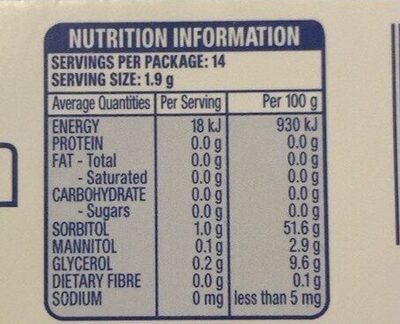Wrigley’s Extra Spearmint Gum - 27g
This product page is not complete. You can help to complete it by editing it and adding more data from the photos we have, or by taking more photos using the app for Android or iPhone/iPad. Thank you!
×
Barcode: 93613903
Quantity: 27g
Brands: Wrigley's
Categories: Snacks, Sweet snacks, Confectioneries, Chewing gum, Sugar-free chewing gum
Labels, certifications, awards: Low or no sugar, No sugar
Manufacturing or processing places: Australia
Stores: Woolworths, Coles, Officeworks, Kmart, Big-W
Countries where sold: Australia, New Zealand
Matching with your preferences
Environment
Packaging
Transportation
Report a problem
Data sources
Product added on by kiliweb
Last edit of product page on by lcmortensen.
Product page also edited by aquilax, archanox, clockwerx, danzo7, ecoscore-impact-estimator, openfoodfacts-contributors, packbot, yuka.UUo4alAvNDdxYWM3dGZNZDVCRHYyUDR1N1krWVlVaTZBTmd4SUE9PQ, yuka.sY2b0xO6T85zoF3NwEKvllNOVf_9hmj-MRLQhXCPyozePJvib_dw87noLKg, yuka.sY2b0xO6T85zoF3NwEKvlm4eA-SE8wmUbgPUi1WJx962FcTVP8F-zbjmHqs, yuka.sY2b0xO6T85zoF3NwEKvlmpJbfXUpBjlMCbTglKG24-McoPJTuAi-avbDqs.









